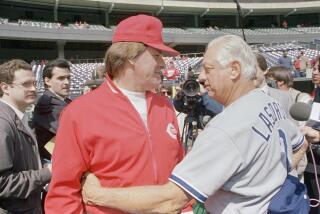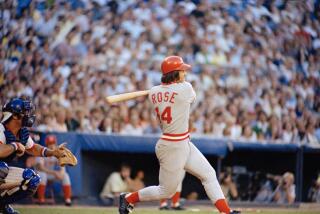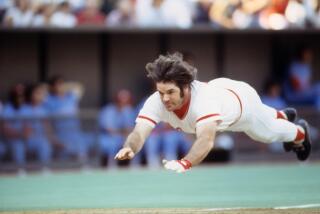Seaver and Fingers Join the Hall of Fame : Baseball: Detroit wartime great Newhouser, umpire McGowan also inducted in first year Rose would have been eligible.
COOPERSTOWN, N.Y. — Tom Seaver used his induction into the Hall of Fame to make another perfect delivery.
Seaver, Rollie Fingers, Hal Newhouser and the late umpire Bill McGowan were inducted Sunday before a crowd of more than 15,000 on the grounds outside Alfred Clark Gymnasium.
The ceremony was moved from its usual site, the Hall of Fame library, which is under construction. But the location did not matter.
“It is the last beautiful flower in a perfect bouquet,” Seaver said to an audience that included more than 30 Hall Famers, including Ted Williams, Stan Musial and Johnny Bench.
This also was the first year Pete Rose would have been eligible for the Hall of Fame. But the doors of Cooperstown were locked to Rose after he was barred from baseball for gambling on the sport.
Rose was a distant memory on this day, however, as thousands of Met fans made the three-hour journey from New York to thank Seaver for the memories.
Among the highlights were his 25-7 season in 1969, his near-perfect game against the Chicago Cubs and his 19 strikeouts, including 10 in a row, against the San Diego Padres in 1970.
Not all of his success was achieved with the Mets. He pitched a no-hitter and struck out his 3,000th batter with Cincinnati and recorded his 300th victory when he was with the Chicago White Sox.
Seaver finished his career with 311 victories, a 2.86 earned-run average, 3,640 strikeouts and 61 shutouts.
He currently is a broadcaster for the New York Yankees, and there are reports he might be considered as the successor to NL President Bill White.
As usual, Fingers was around to mop up what cheers were left after the demonstration for Seaver.
But Fingers was used to this role.
Fingers retired after the 1985 season with a record 341 saves, broken this year by Boston’s Jeff Reardon. He also had seven saves in the World Series and helped Oakland win three consecutive titles from 1972-74.
“I think I’m most proud of the position I played,” Fingers said. “There were a lot of great relief pitchers before me. I happened to be at the right place, at the right time with the right team.”
He was known for his control, durability and his handlebar mustache. All the A’s wore beards or mustaches, but Fingers’ was famous.
When Fingers became a free agent, he talked with the Cincinnati Reds, but the Reds had a policy that prohibited facial hair, and that ended discussions.
As a member of the Milwaukee Brewers in 1981, Fingers had 28 saves and a 1.04 ERA en route to the AL Cy Young Award and most-valuable-player award. In helping the Brewers gain their first postseason appearance, Fingers figured in 55% of Milwaukee’s victories.
Newhouser dominated baseball in the mid-1940s, winning the MVP award in ’44 and ’45. But that’s when a lot of the major league’s best players were in the service during World War II, and some suggested Newhouser’s success was a result.
But when war veterans returned in 1946, Newhouser won 26 games and posted a 1.94 ERA for the Detroit Tigers. The left-hander pitched from 1939-55 and had a career record of 207-150.
He is the only pitcher in major league history to win consecutive MVP awards.
Newhouser became a major leaguer at 18 in 1939 and was only 25-43 through 1941. He started his career 0-1, 9-9, 9-11 and 8-14--hardly Hall of Fame numbers.
Known as a temperamental sort, Newhouser finally put it all together and won 29 games in 1944. The Tigers went to the World Series in 1945, and Newhouser was the winning pitcher in the seventh game against the Chicago Cubs. He was 25-9 in 1945.
McGowan umpired 2,541 consecutive games from 1925-41. He worked eight World Series and four All-Star games.
More to Read
Go beyond the scoreboard
Get the latest on L.A.'s teams in the daily Sports Report newsletter.
You may occasionally receive promotional content from the Los Angeles Times.










